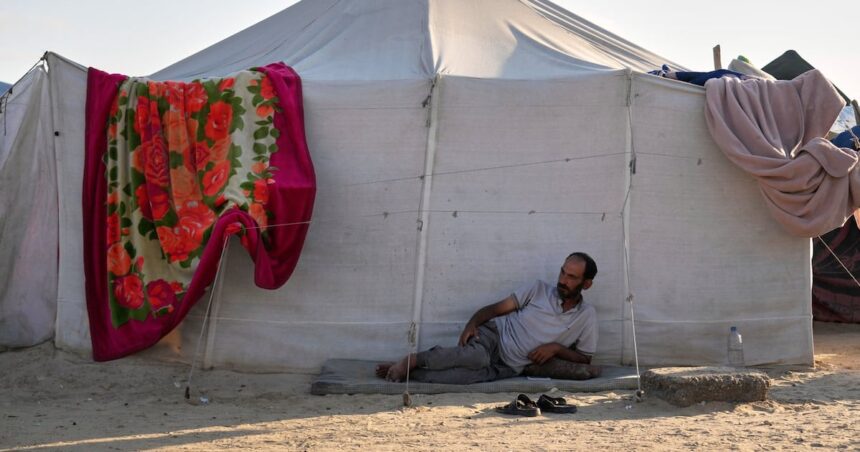I’ve spent the past three days monitoring diplomatic channels in Cairo, where negotiators have been working relentlessly on what could become the first significant ceasefire between Israel and Hamas since October. The air in these corridors feels different this time—a mixture of exhaustion and the faintest glimmer of possibility.
“We’ve never been closer,” a senior Egyptian official told me yesterday, speaking on condition of anonymity due to the sensitivity of the talks. “But the distance between ‘close’ and ‘done’ remains treacherous.“
This diplomatic push comes against a backdrop of devastating violence. Israeli airstrikes killed at least 38 Palestinians in Gaza on Tuesday, including 14 children, according to the Gaza Health Ministry. The strikes hit areas in central Gaza where thousands of displaced families had sought refuge after fleeing from previous bombardments.
Meanwhile, in Washington, President Biden characterized the current proposal as “the most promising path forward,” while emphasizing that “Israel has made significant concessions.” His administration has been applying increasing pressure on both sides to reach an agreement that would include the release of hostages held by Hamas and Palestinian prisoners detained by Israel.
Hamas officials in Doha remain cautious. “We welcome any serious initiative that ensures a permanent ceasefire and complete withdrawal of Israeli forces,” said Osama Hamdan, a senior Hamas official I spoke with via telephone. However, he stressed that Hamas would not accept any agreement that leaves Israeli troops in strategic positions throughout Gaza or fails to address humanitarian catastrophe.
The human toll of this war has reached staggering proportions. According to the United Nations Office for the Coordination of Humanitarian Affairs, more than 34,500 Palestinians have been killed since October, with women and children representing a significant percentage of casualties. Israeli authorities report that approximately 1,200 people were killed in the October 7 Hamas attack, with about 120 hostages still believed to be held in Gaza.
In Rafah, where I visited last month before access became even more restricted, conditions had deteriorated beyond what words can adequately convey. Makeshift shelters constructed from tarpaulins and salvaged materials stretched across once-empty fields. A doctor at a field hospital—operating with minimal supplies and overwhelming patient loads—told me they were “practicing medicine from the previous century.”
“We’re not just treating war wounds anymore,” Dr. Fatima al-Najjar explained. “We’re seeing diseases we haven’t encountered in decades—cholera, hepatitis, severe malnutrition. The blockade kills as effectively as bombs.“
The economic devastation compounds the humanitarian crisis. The World Bank estimates Gaza’s economy has contracted by approximately 80% since October, with unemployment now exceeding 85%. Essential infrastructure—water treatment facilities, power stations, hospitals—lies in ruins.
The current ceasefire proposal, according to sources familiar with the negotiations, consists of three phases. The first would include a six-week pause in fighting, the release of some hostages in exchange for Palestinian prisoners, and increased humanitarian aid. Subsequent phases would address longer-term arrangements and reconstruction efforts.
Israeli Prime Minister Netanyahu faces significant domestic pressure from both directions—families of hostages demanding a deal to bring their loved ones home, and far-right coalition partners threatening to collapse his government if he makes too many concessions. During a press conference Tuesday, Netanyahu insisted that “Israel will maintain security control over Gaza” regardless of any agreement.
For Gazans, the prospect of a ceasefire offers desperately needed respite, though many wonder what will remain when the bombing stops. “My neighborhood doesn’t exist anymore,” said Mahmoud Bashir, a 43-year-old teacher from Gaza City now sheltering near Khan Younis. “Even if the shooting stops tomorrow, where do we go? What do we return to?”
International aid organizations emphasize that any ceasefire must be accompanied by unrestricted humanitarian access. The International Committee of the Red Cross reports that functional healthcare capacity in Gaza has been reduced by approximately 70%, while daily caloric intake for most residents has fallen well below minimum survival requirements.
The ripple effects of this conflict extend well beyond Gaza’s borders. In Lebanon, exchanges of fire between Israeli forces and Hezbollah have intensified. Yemen’s Houthi rebels continue targeting shipping in the Red Sea, disrupting global trade routes. And throughout the Middle East, massive protests have put unprecedented pressure on governments aligned with Western powers.
Whether these ceasefire talks succeed remains uncertain. Previous negotiations have collapsed at the eleventh hour. But the humanitarian imperative grows more urgent by the day. As one European diplomat involved in the talks told me, “This isn’t just about ending a war anymore. It’s about preventing a complete collapse of human society in Gaza.“
As night falls in Cairo, negotiators prepare for another round of discussions. For families huddled in Gaza’s shrinking safe zones and for the hostages’ relatives maintaining vigil in Tel Aviv, these diplomatic formulations represent something far more immediate than geopolitics—they represent survival itself.






